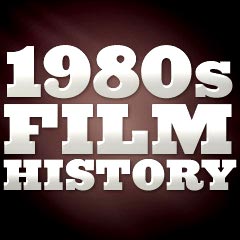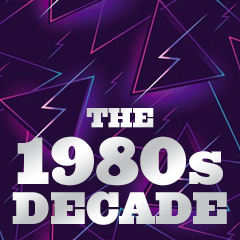|
Trends of the 70s Extend Into the 80s: The Introduction of
'High-Concept' Films
The decade of the 1980s tended to consolidate the gains made in the
seventies rather than to initiate any new trends equal to the large number
of disaster movies, buddy movies, or "rogue cop" movies that characterized
the previous decade. Designed and packaged for mass audience appeal, few
80s films became what could be called 'classics'.
The era was characterized by the introduction of 'high-concept' films
- with cinematic plots that could be easily characterized by one or two
sentences (25 words or less) - and therefore easily marketable and understandable.
Producer Don Simpson (partnered with Jerry Bruckheimer) has been credited
with the creation of the high-concept picture (or modern Hollywood blockbuster),
although its roots could be seen in the late 70s (i.e., the prototypical
Jaws (1975), Saturday Night Fever (1977),
Star Wars (1977), Alien
(1979) - known in high-concept terms as "Jaws in Space").
Simpson was the first producer to understand and exploit the significance
of MTV. His action-packed, loud, flashy, simplistic, and tightly-structured
films brought crowds to the multiplexes every summer. His lowest common-denominator
films reflected the MTV generation, such as in his debut film Flashdance
(1983) - with its pop soundtrack and iconic 'freeze-frame' ending.
Other successes followed in the 80s: Beverly Hills Cop (1984) with
its 'fish-out-of-water' high concept, the sexy Thief of Hearts (1984),
the high-flying Top Gun (1986) - the epitome of Simpson's technique,
and the stock-car racing film Days of Thunder (1990) again with
Tom Cruise. By the end of the 80s era as a result, most films were not
designed for 'thinking' adult audiences (such as Driving Miss Daisy
(1989)), but were 'low-brow' for dumbed-down teen audiences looking
for sheer entertainment value or thrills (for example, Bill & Ted's
Excellent Adventure (1989), James Cameron's Aliens (1986),
or Die Hard (1988)).
After the innovations of the 70s, films in the 80s were less experimental
and original, but more formulaic, although there was a burst of films
eager to capitalize on new special effects (CGI) techniques - now available.
Predictions were grim for the industry - production costs were soaring
while ticket prices were declining. The average ticket price at the beginning
of the decade was about $3, and over $4 by the end of the decade, while
the average film budget was over $18 million. However, fears of the demise
of Hollywood proved to be premature.
The Search for a Blockbuster:
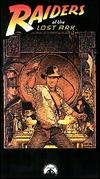 The
personal cinema of 70s auteur directors such as Francis Ford Coppola,
William Friedkin, Peter Bogdanovich, Martin Scorsese and Steven Spielberg
was now superceded by the advent of the "blockbuster" phenomenon
that they had created (with The Godfather (1972)
and Jaws (1975)). The industry continued
to pander to the tastes and desires of young people - one of the negative
legacies of Star Wars (1977) of the late
70s. The
personal cinema of 70s auteur directors such as Francis Ford Coppola,
William Friedkin, Peter Bogdanovich, Martin Scorsese and Steven Spielberg
was now superceded by the advent of the "blockbuster" phenomenon
that they had created (with The Godfather (1972)
and Jaws (1975)). The industry continued
to pander to the tastes and desires of young people - one of the negative
legacies of Star Wars (1977) of the late
70s.
Steven Spielberg's and George Lucas' names have often been associated
with the term "blockbuster" - and their films inevitably continued to
contribute to the trend during this decade, such as The Empire Strikes
Back (1980), the great and exhilarating escapist-adventure film Raiders of the Lost Ark (1981),
Return of the Jedi (1983), and the childhood fantasy hit E.T.: The
Extra-Terrestrial (1982) with a lovable stranded alien, inspired by Peter Pan, the resurrection themes of Christianity, and with an anti-science bias. There were others that were successful,
such as Ghostbusters (1984), Romancing the Stone (1984),
and Back to the Future (1985), and their successive sequels.
Following this model, Hollywood continued to search, with
demographic research and a "bottom line mentality," for the
one large "event film" that everyone (including international audiences)
had to see (with dazzling special effects technology, sophisticated
sound tracks, mega-marketing budgets, and costly, highly-paid stars).
Most big-screen event movies, scheduled to be released at advantageous
times (at summer and Christmas-time) would take expensive fortunes to
produce - but they promised potentially lucrative payoffs. In retrospect,
many of the blockbusters in the 80s, such as those mentioned above, were
well-constructed films with strong characters and plots not entirely built
upon their special-effects.
Big Losers, Flops and Bombs: Turkeys of the 80s Decade
See extensive sub-section of site on "Greatest Box-Office Bombs, Disasters, and Flops".
There were a number of highly-touted films of the era
that fared very poorly. Within a few years, it was becoming clear that
blockbusters would not always insure instant profits and success:
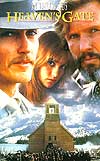 Auteur
Michael Cimino's and United Artists' incomprehensible, over-long epic Western film
Heaven's Gate (1980) about Wyoming's Johnson County wars cost
almost six times above-budget to produce (from $7.5 million to about
$44 million). It was originally
a 5-hour 25 minute version that was cut down to 219 minutes for its November, 1980 NYC premiere. The film was immediately pulled, re-cut and then
re-released five months later (after being shortened by 70 minutes) in 1981
- and still failed due to bad press. It stunned its studio by becoming the biggest flop in
film history at the time (US box-office was about $1.5 million) - it
lost at least $40 million. UA's corporate parent, Transamerica, had to sell
the studio to MGM for only $350 million as a result. [UA was responsible
for earlier hits Midnight Cowboy (1969),
Annie Hall (1977) and the James Bond
films.] Auteur
Michael Cimino's and United Artists' incomprehensible, over-long epic Western film
Heaven's Gate (1980) about Wyoming's Johnson County wars cost
almost six times above-budget to produce (from $7.5 million to about
$44 million). It was originally
a 5-hour 25 minute version that was cut down to 219 minutes for its November, 1980 NYC premiere. The film was immediately pulled, re-cut and then
re-released five months later (after being shortened by 70 minutes) in 1981
- and still failed due to bad press. It stunned its studio by becoming the biggest flop in
film history at the time (US box-office was about $1.5 million) - it
lost at least $40 million. UA's corporate parent, Transamerica, had to sell
the studio to MGM for only $350 million as a result. [UA was responsible
for earlier hits Midnight Cowboy (1969),
Annie Hall (1977) and the James Bond
films.]
Since then, the film has been synonymous for any film facing major financial
disaster and for the director-centric era of the 70s. Bank-rolled support for independent 'auteur' directors of
the New Wave of 70s directors (who controlled their own production costs
with little studio oversight) ended when this film's egotistical director
(Best Director winner for The Deer Hunter (1978))
was criticized as being self-indulgent, financially irresponsible and
ego-driven. The end of the era also arrived due to similar failures
by other auteurs: Peter Bogdanovich with At Long Last Love (1975),
Martin Scorsese with New York, New York (1977) and even Steven
Spielberg with 1941 (1979). [Martin Scorsese's planned film project
Gangs of New York (2002) (with 10 Oscar nominations, including
Best Picture), first conceived in 1978, was shelved as a result, and
released many years after initial plans and screenplay completion.]
- MGM/UA's and Terence Young's Korean
War epic Inchon (1981) with Laurence Olivier (as General Douglas
MacArthur) was produced by Rev. Sung Myung Moon and his Reunification
Church - it was an embarrassment that was quickly withdrawn, with a
budget of about $50 million and a US box-office of only $5 million.
- Hugh Hudson's (famous for the Oscar-winning Chariots
of Fire (1981)) miscalculated historical epic of the American Revolution
was WB's Revolution (1985), with star Al Pacino miscast as an
18th century New York fur trapper. It grossed only $359,000 on a budget
of about $28 million. The film's colossal failure curtailed Hudson's
major directorial efforts until the big-budget I Dreamed of Africa
(2000) 15 years later, and Pacino wouldn't star in another film
for four years (until Sea of Love (1989)).
- John Huston's first and sole musical, Annie (1982),
a dull, uninspired major flop (that barely broke even) - inspired by
the Broadway musical. The rights to the show were sold in 1978 for $9.5
million, the highest amount ever at the time.
- Howard the Duck (1986), based on Steve Gerber's 70s Marvel Comics character (which went out of print in 1981), and from executive producer George Lucas (and his screenwriting pal, director Willard Huyck), was one of the worst and least successful big-budget films ever made. Lucas hired Willard Hyuck and his wife Gloria Katz (the screenwriter for Lucas' film American Graffiti (1973)) to write the big-screen version. This misguided Universal film domestically grossed about $15 million on a budget of $30 million.
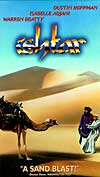 The
highly-anticipated Shanghai Surprise (1986), produced by Handmade
Films (headed by the Beatles' George Harrison), starred newlyweds: pop diva
singer Madonna and volatile actor Sean Penn. Lacking a coherent plot
and without any chemistry between the two leads in poorly-acted characterizations,
the overlong film failed miserably (with a box-office take of only $2.3
million with a budget of $17 million) and was nicknamed "Flop Suey". The
highly-anticipated Shanghai Surprise (1986), produced by Handmade
Films (headed by the Beatles' George Harrison), starred newlyweds: pop diva
singer Madonna and volatile actor Sean Penn. Lacking a coherent plot
and without any chemistry between the two leads in poorly-acted characterizations,
the overlong film failed miserably (with a box-office take of only $2.3
million with a budget of $17 million) and was nicknamed "Flop Suey".
- Columbia Pictures' and writer/director Elaine May's
Ishtar (1987), was a poor imitation of the Hope/Crosby/Lamour
"Road" pictures. It was a very expensive comedy film ($55
million) with only a small box-office gross of about $14 million, was
a tremendous disaster and one of the worst films ever made according to some reviewers - in spite
of its stars Warren Beatty, Isabelle Adjani and Dustin Hoffman (who
won an Oscar the next year for Rain Man (1988)!).
- Writer/director Terry Gilliam's (of Monty Python
fame) deeply-troubled but visually-captivating fantasy production of
The Adventures of Baron Munchhausen (1989)
was a major failure, due to production delays, legal issues, and on-location
difficulties. Despite four Oscar nominations, it had a US gross of only
$8 million with a film budget of about $46 million.
- And one more at the start of the 90s, director Brian De Palma's political
satire The Bonfire of the Vanities (1990), vaguely based upon Tom
Wolfe's best-selling saga about stockbroker Sherman McCoy, featured
multi-million dollar contracts for its miscast stars Tom Hanks and Bruce
Willis. Savaged by critics, it had a budget of $47 million, and grossed
only about $16 million.
Unexpected Successes:
Who would know or be able to predict that other films would be successful:
- Louis Malle's low-budget, overly-long My Dinner
With Andre (1981) with fascinating dinner conversation between actor/playwright
Wallace Shawn and theater director Andre Gregory
- Victor/Victoria (1982),
set in 1930s Paris, in which Julie Andrews pretended to be a man --
pretending to be a woman, something that confused James Garner
- Martin Scorsese's The King of Comedy (1982), a dark comedy about the search for stand-up comic celebrity by Rupert Pupkin (Scorsese's favorite actor Robert DeNiro), self-proclaimed as The "King of Comedy"; the film also featured an appearance by real-life comedian Jerry Lewis as arrogant Jerry Langford -- Pupkin's talk-show host idol -- who was kidnapped and tied up (and duct-taped) with assistance from his accomplice Masha (Sandra Bernhard) after Pupkin was snubbed, so that he could take his spot on the show
- Milos Forman's Best Picture-winning Amadeus
(1984),
a quasi-biopic (adapted by Peter Shaffer from his own play) without
big-name stars about foul-mouthed composer-genius Wolfgang
Amadeus Mozart (Tom Hulce) and rival court composer Antonio
Salieri (F. Murray Abraham) vying for the favor of an Austrian
Emperor
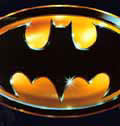 James
Cameron's The Terminator (1984) was a
story about Sarah Connor - the unsuspecting future mother of John - the leader of
a human rebellion against the machines (which were exemplified by the brutal metallic cyborg
T-800 played by Arnold Schwarzenegger, who journeyed back in time to assassinate her); the intense and lean film established an action film genre
that extends to the present day James
Cameron's The Terminator (1984) was a
story about Sarah Connor - the unsuspecting future mother of John - the leader of
a human rebellion against the machines (which were exemplified by the brutal metallic cyborg
T-800 played by Arnold Schwarzenegger, who journeyed back in time to assassinate her); the intense and lean film established an action film genre
that extends to the present day - the musical comedy Little
Shop of Horrors (1986), originally a Roger
Corman horror film in the 60s, about a florist shop that spawned a hungry
plant named Audrey II that consumed demented dentist Steve Martin as
one of its victims; its song "Mean Green Mother From Outer Space"
was Oscar-nominated
- Tim Burton's ambitious, hyped and over-marketed production
of a dark-shaded Batman (1989) - a Warners' mega-hit film promoted
with lucrative merchandising that became the blockbuster hit of the
last year of the decade, with an over-the-top performance by Jack Nicholson
as the villainous Joker ("Where does he get those wonderful toys?")
and comedian Michael Keaton in a serious, dual role as the comic book
hero - the dark avenger of Gotham City
Big Business Entertainment:
Film budgets skyrocketed due to special effects (expensive digital effects)
and inflated salaries of name-recognition stars (and their agents). Big
business increasingly took control of the movies and the way was opened
for the foreign (mostly Japanese) ownership of Hollywood properties. To
save money, many more films were being made in non-US locations by mid-decade.
A number of the studios were taken over by multi-national conglomerates
as their entertainment divisions:
- United Artists (acquired in 1969 by airline
tycoon Kirk Kerkorian and temporarily abandoned) was bought and merged
with MGM in 1981 to form MGM/UA; the company's film library was
bought out by media mogul Ted Turner in 1986 for his cable TV channel,
Turner Broadcasting System, Inc.; then, in 1990 MGM was purchased
by Sony Entertainment of Japan - home to both Columbia Pictures and
TriStar Pictures (see below)
- 20th (or Twentieth) Century Fox was taken over
by oil tycoon Marvin Davis in 1981 and then entered into a 50% shared
ownership with Australian publisher Robert Murdoch in 1985, becoming
part of Fox, Inc. The film production unit was renamed simply
Fox Film Corporation in 1989, and by the end of the century became
known simply as Fox
- Columbia Pictures was purchased by the Coca-Cola
Company in 1982; (Tri-Star Pictures was also created -
a joint venture of Columbia Pictures, HBO, and CBS); Tri-Star Pictures
bought Loew's Theaters in 1986; British film producer David Puttnam
briefly headed Columbia Pictures for a few years beginning in 1986;
the Sony Corporation of America purchased Columbia Pictures Entertainment,
Inc. and Tri-Star Pictures from Coca-Cola for $3.4 billion in 1989,
re-naming itself Sony Pictures Entertainment; in 1992, Sony
Pictures Classics became an autonomous company within Sony Pictures
- Paramount became a wholly owned
subsidiary of Gulf + Western Industries, Inc in 1966; in 1989,
Gulf + Western was reconfigured and renamed Paramount Communications,
Inc.; then in 1994, Paramount merged with Viacom International
- MCA/Universal (which had officially merged
in 1962) became a powerful TV production company, and started its organized
studio tours - one of LA's most popular tourist attractions; they were
acquired by Matsushita Electrical Industrial, Co. in 1991; in June 1995,
The Seagram Company Ltd. (VO) purchased a majority equity in MCA from
Matsushita; then in late 1996, MCA Inc. was renamed Universal
Studios, reclaiming its heritage as one of the industry's oldest
and most prestigious movie studios
- Walt Disney Productions remained as one of the
few studio-era survivors, with Michael Eisner as chairman and CEO beginning
in 1984; it set up Touchstone Pictures in 1984 to make feature
films that appealed to adult audiences; Buena Vista was Disney's
distributor
- Warner Communications merged with Time, Inc.
- announced in 1989 (and completed in 1990) to become Time-Warner, Inc., a component of the media
empire AOL-Time Warner
A few independent film companies, such as New Line
Cinema and Miramax, began to make more experimental and offbeat
films to fill the gaps provided by the major studios.
Because costly film decisions were more in the hands of people making
the financial decisions, not the film makers, movies were made only if
they could guarantee financial success, thereby pandering to a few select,
well-known star names attached to film titles without as much attention
paid to intelligent scripts. With this kind of pressure, the most popular
film stars demanded higher salaries, up front, and well as a percentage
of the film's gross take, earning as much as $20 million. Budgets and
actors salaries skyrocketed out of control, and powerful agents for agencies
such as Creative Artists Agency (CAA) negotiated outrageous deals.
Notable 1980s Milestones:
- 36 year old Sherry Lansing was named president of production
at 20th Century Fox in 1980 - and became the first female to hold this
position and head a major studio (she resigned in 1982 to become an
independent producer)
- Dawn Steel became VP for production at Paramount Studios
in 1980, and then president of Columbia Pictures in 1987
- in 1980, CNN (Cable News Network) began
operations
- in the early 1980s, Sony's
superior video recording standard, termed Betamax, was overtaken
by VHS (Video Home System) developed by JVC, with a longer record
time of 2 hours; in 1987, when VHS commanded 95% market share, Sony
finally began to abandon Betamax
- in 1980, Pioneer began to market its videodisk
(laserdisc) players, thereby widening the availability of films for
consumer viewing and purchase
- former Beatle John Lennon was shot dead on December
8, 1980 as he entered his New York apartment by Mark Chapman
- in 1981, the music-video cable network MTV began
broadcasting on August 1st at 12:01 am - the first music video that
was aired was Video Killed the Radio Star - the debut single
of the British duo - the Buggles
- child-teen star and cover model Brooke Shields was
the most sought-after actress of the early 80s - projecting both innocence
and sexuality
- director Milos Forman's Ragtime (1981) was legendary
actor James Cagney's first film - a "comeback" - after 20
years of retirement
- Ronald Reagan, a former President of the Screen Actor's
Guild (from 1947-1952) and governor of California, became the first
movie-star President of the US (the 40th) in 1981. His conservative
reign and hard-edged approach toward the Soviet Union was reflected
in Hollywood's many action-adventure films of the decade with aggressive,
macho stars (Rocky, Rambo, Arnold Schwarzenegger, Chuck Norris, Steven
Seagal, Clint Eastwood and others) - even his futuristic anti-missile
defense system co-opted the name of Lucas' 70s film Star Wars
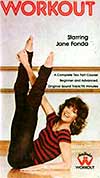 Jodie
Foster was stalked by mentally-impaired John Hinckley, who tried to
impress the actress by attempting to assassinate Reagan in late March,
1981 Jodie
Foster was stalked by mentally-impaired John Hinckley, who tried to
impress the actress by attempting to assassinate Reagan in late March,
1981 - actress and aerobics guru Jane Fonda (sporting a striped
leotard and leg warmers) released a workout videotape, Jane Fonda's
Workout (1982), that became one of the hottest best-sellers for
years, due to the increased proliferation of the home VCR
- George Lucas' THX sound system made its debut - the
first movie to be shown in a THX-certified auditorium was Return
of the Jedi (1983) - see more below
- during the making of Twilight Zone: The Movie (1983)
in 1982, two child actors and Vic Morrow were killed in a freak helicopter
crash - as a result, greater precautions would be taken on Hollywood
sets
- Walt Disney Productions and Westinghouse Broadcasting
launched the cable network The Disney Channel in April, 1983
- future singer/actress Vanessa Williams won the 1984
Miss America title (crowned in September, 1983, she became the first
black woman ever to possess the title), but she resigned when it was
revealed that she had posed for some sexually explicit photos (taken
in 1982) that appeared in two issues of Penthouse magazine (September,
1984 and January, 1985)
- in 1983, 20th Century Fox began to openly solicit
deals to display brand names in its films
- the American Movie Classics cable-TV channel
started operations in 1984
- in 1984, the Voyager Company introduced its Criterion
Collection line of 'special edition,' high-quality, feature-packed
laserdiscs, often with state-of-the-art transfers, the CAV (full feature)
format, the full theatrical 'letter-box' format, special commentary
tracks and supplemental material, dual audio, interviews and annotated
commentary by film-makers and scholars, director's cuts, deleted scenes,
storyboards and production designs, and other bonus features (theatrical
shorts or trailers, shooting scripts, posters, stills galleries, print
booklets, out-takes, dual versions of a film, and other extras, etc.)
that have since become commonplace on DVDs by the turn of the century
- in 1985, the first bricks-and-mortal Blockbuster
video rental store opened in Dallas, TX and became a major alternative
to small, local operations with limited video rental selections.
It grew to become a major nationwide chain of stores, yet faced
increased competition from video-on-demand (VOD), satellite TV,
and lower-priced tapes combined with a shrinking market in the
late 1990s.
- in 1985, Robert Redford's Sundance Institute (established
in 1980) took over the Utah/US Film Festival and later renamed it the Sundance
Film Festival (held annually in January) - "dedicated to the
support and development of emerging screenwriters and directors of vision,
and to the national and international exhibition of new, independent
dramatic and documentary films"
- Rock Hudson's homosexuality was revealed when he became
the first major film industry figure to die of AIDS in October of 1985
- on September 8, 1986, Oprah Winfrey became the first
African-American woman to host a nationally-syndicated daytime talk
show, titled "The Oprah Winfrey Show"
- in 1987, Premiere Magazine began publishing
- The Dead (1987) was legendary director John
Huston's last film, with top-billing given to his daughter Anjelica
Huston and a script co-written by his son Tony
- the oldest performer to win the Best Actress Oscar
was 81 year-old Jessica Tandy for Driving Miss Daisy (1989)
New Technologies: Home Entertainment-Video, Cable TV, and Sound
Cable TV networks, direct broadcast satellites, and 1/2 inch videocassettes
(in the VHS format) in the 80s encouraged broader distribution of films.
Sales and revenues from pre-sold theatrical features for videocassette
reproduction and cable TV distribution contributed increased percentages
for studios' earnings - sometimes outpacing box-office profits. [In an
influential decision, the Supreme Court ruled in the case of Universal
v. Sony Betamax (1984) that home video-taping for personal use was
not a copyright infringement.]
 Many
studios entered the business of producing films for commercial TV networks,
and the release of their films for the home entertainment-video market
became a profitable rental-sales business. The pre-recorded video of Disney's
Sleeping Beauty (1959) brought sales of over a million copies when
it was released in 1986. And then to illustrate the burgeoning video industry
over the next few years, 1988 sales of E.T.: The
Extra-Terrestrial (1982) surpassed 15 million! Many
studios entered the business of producing films for commercial TV networks,
and the release of their films for the home entertainment-video market
became a profitable rental-sales business. The pre-recorded video of Disney's
Sleeping Beauty (1959) brought sales of over a million copies when
it was released in 1986. And then to illustrate the burgeoning video industry
over the next few years, 1988 sales of E.T.: The
Extra-Terrestrial (1982) surpassed 15 million!
Tri-Star Pictures Motion Picture Company,
one of Hollywood's major producer/distributors, was created in 1983
as a joint venture of CBS Inc., Columbia Pictures, and Time-Life's
premium cable service Home
Box Office (HBO) (founded in 1972). HBO and Showtime both
functioned as producer/distributors in their own right by
directly financing films and entertainment specials for
their own pay-television cable stations. HBO became
a leader, developing the first made-for-pay-TV movie The
Terry Fox Story (1983). It became the first cable network
to win an Oscar, for Best Documentary Feature for Down
and Out in America (1986), and an Emmy, for Dear America:
Letters Home From Vietnam (1987). By the 1990s, all the
major pay-TV cable networks had expanded their output, creating
original series, films and mini-series, along with producing
documentaries, stand-up comedy, and sports programming.
[In 1989, Time Inc. merged with Warner Communications,
becoming the major media giant Time-Warner.] The spread of
access to cable television (and satellite broadcasts) threatened
traditional one-screen theatres and film attendance. On the other
hand, multi-plex movie theatres with multiple screens spread across
the country during the 80s, while the number of drive-in theatres
drastically declined.
 Multi-track
Dolby stereo sound, the THX sound system (named after George Lucas' first
feature film), and Dolby SR ("spectral recording") (all designed
to produce higher quality sound, noise reduction, surround-sound and other
special effects) were introduced in the 70s and 80s, and advertised as
a special feature for films such as Amadeus (1984) and Aliens
(1986). The first movie to be shown in a THX-certified auditorium
was Return of the Jedi (1983). [In 1992, a new technology dubbed
Dolby Digital was introduced to movie-goers in Batman Returns (1992),
and then DTS Digital Sound made its debut in Jurassic Park (1993).] Multi-track
Dolby stereo sound, the THX sound system (named after George Lucas' first
feature film), and Dolby SR ("spectral recording") (all designed
to produce higher quality sound, noise reduction, surround-sound and other
special effects) were introduced in the 70s and 80s, and advertised as
a special feature for films such as Amadeus (1984) and Aliens
(1986). The first movie to be shown in a THX-certified auditorium
was Return of the Jedi (1983). [In 1992, a new technology dubbed
Dolby Digital was introduced to movie-goers in Batman Returns (1992),
and then DTS Digital Sound made its debut in Jurassic Park (1993).]
 Film History of the 1980s
Film History of the 1980s
Part 1, Part 2, Part 3, Part 4, Part 5, Part 6

 
|
